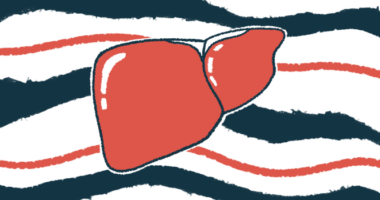Blood marker can predict liver function improvement in PBC
LMR may help ID patients with greater chance of recompensation

A blood marker of inflammation called lymphocyte-to-monocyte ratio (LMR) is an independent predictor of liver recompensation — when liver function improves with treatment despite permanent scarring — in people with primary biliary cholangitis (PBC).
That’s according to a new study from researchers in China that showed that higher blood LMR levels — denoting a less active inflammatory state — were significantly associated with a greater chance of liver recompensation. The researchers also noted that “the predictive performance of LMR surpasses that of other established inflammatory markers.”
The study, “Lymphocyte-to-Monocyte Ratio as a Predictor of Recompensation in Patients With Decompensated Primary Biliary Cholangitis,” was published in the journal Alimentary Pharmacology & Therapeutics.
“These findings underscore the potential of LMR as a simple, readily available, noninvasive biomarker that may reflect the immune-inflammatory [environment] in PBC,” two scientists not involved in the study wrote in an accompanying editorial.
“LMR could be incorporated into composite tools to stratify decompensated PBC patients by likelihood of recompensation,” the scientists wrote, suggesting the marker could be used as a way to identify those individuals with a greater chance of improved liver function.
PBC is a chronic type of cholangitis — inflammation in the series of tubes that carry bile, a digestive fluid, from the liver to the intestines. Such inflammation blocks bile flow, causing it to build up to toxic levels in the liver, which disrupts liver function. Over time, bile toxicity can lead to cirrhosis, or permanent liver scarring.
Blood samples from 400 PBC patients used to test marker
Patients with cirrhosis have an increased risk of decompensation, when the liver can no longer perform its functions due to extensive scarring. This can lead to noticeable complications, including fluid buildup in the abdomen (ascites), bleeding in the upper gastrointestinal tract (esophageal variceal bleeding), and liver failure.
In addition, “transplant-free survival rate of these patients declines markedly,” the researchers wrote.
However, evidence suggests that ursodeoxycholic acid (UDCA), the first-line therapy for PBC, can help some patients with decompensated cirrhosis achieve recompensation, or a return to a compensated state, in which the liver’s ability to perform its essential functions improves and decompensation manifestations are resolved.
“Early identification of patients who are likely to achieve recompensation and timely intervention are crucial for improving the prognosis of PBC patients,” the researchers wrote.
The lymphocyte-to-monocyte ratio, which measures the proportion of two types of immune cells, is an assessment of a person’s immune and inflammatory status. A higher LMR has been associated with better outcomes in cancer and cardiovascular diseases, but “its application in PBC remains limited,” the researchers wrote.
Now, a team led by researchers at the Second Affiliated Hospital of Kunming Medical University evaluated whether LMR could be used to predict recompensation in people with PBC-related decompensated cirrhosis. The researchers analyzed blood samples from 401 people with PBC-related decompensated cirrhosis who were seen at a single Chinese hospital between January 2013 and December 2023.
Most participants (86%) were women, and their median age was 60. The most common initial decompensating event was ascites (62%), followed by variceal bleeding (24%) and hepatic encephalopathy (13%), an altered state of consciousness due to liver disease.
During follow-up, 26% of patients achieved recompensation, defined as a UDCA treatment response, resolution of decompensating events, and stable liver function improvement.
A significantly higher proportion of people in the recompensation group were alive relative to the nonrecompensation group at one year (97% vs. 78%), three years (92% vs. 59%), and five years (87% vs. 46%).
Recompensation 5 times more likely with LMR in highest range
Recompensation occurred significantly more often in PBC patients with the highest LMR values compared with those with the lowest LMR values.
The benefits of a high LMR remained after adjusting for factors that may influence the results, such as demographics, coexisting medical conditions, and various clinical assessments and blood tests. Specifically, people with LMR values within the highest range had a nearly fivefold higher chance of recompensation than those with LMR values within the lowest range.
In adjusted predictive analyses, the team identified higher LMR and body mass index (a ratio of height and weight) as independent predictors of recompensation, and higher blood bilirubin levels, indicative of liver damage, as an unfavorable predictor.
This study demonstrates for the first time that LMR is an independent predictor of recompensation in patients with decompensated PBC, with higher LMR levels significantly increasing the likelihood of achieving [improved liver function].
Researchers also tested the predictive performance of additional inflammatory markers based on ratios or equations of immune-related cells like lymphocytes and neutrophils, and blood clot-forming platelets. These included the neutrophil-to-lymphocyte ratio (NLR), the platelet-to-lymphocyte ratio (PLR), and the systemic immune-inflammation index (SII).
Predictive capacities were assessed using the area-under-the-curve (AUC), a statistical method in which values range between zero and one, and values closer to one reflect better accuracy at distinguishing between two states.
LMR had the highest predictive performance regarding recompensation, with an AUC of 0.787, which was significantly superior to NLR at 0.658, PLR at 0.569, and SII at 0.537. In a time-dependent analysis, the AUCs for LMR remained high at one year (0.742), three years (0.742), and five years (0.748), “indicating consistent and robust prognostic capability over time,” the team wrote.
“This study demonstrates for the first time that LMR is an independent predictor of recompensation in patients with decompensated PBC, with higher LMR levels significantly increasing the likelihood of achieving recompensation,” the researchers wrote.
“However, further validation in larger-scale, multicentre prospective studies and in-depth exploration of its underlying biological mechanisms are needed to promote the clinical translation and widespread application of LMR in PBC management,” they concluded.








